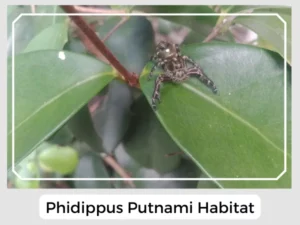Say hello to Phidippus putnami! This lively spider belongs to the jumping spiders family and loves hopping around in North America. We’ve gathered some awesome facts about this jumpy friend for you to explore.
The eggs are laid inside a sac made of thick silk.
On maturing, spiderlings leave their original sac and build their own retreat.
While they do not build webs to capture prey, they spin silk to bind leaves together to create a refuge for themselves.
Yes, Phidippus putnami spiders have venom. They use it to catch the small critters they eat. For most people, this venom isn’t a big deal.
They sure can! But these spiders are more curious than aggressive. They might give a little bite if they feel scared, but they’re mostly busy hopping around.
Phidippus putnami spiders are significant predators in their ecosystems, controlling insect populations. Their jumping behavior not only aids in capturing prey but also in avoiding threats, showcasing an intricate adaptation for survival.
Natural Predators: In the wild, they face dangers from parasitoid wasps and nematodes, which can prey on or parasitize them, reflecting the complex food web interactions within their environment.
Prey-Predator Dynamics: By preying on a variety of insects, Phidippus putnami spiders help in pest control and the maintenance of a balanced ecosystem. Their predation helps keep insect populations in check, which can be beneficial for human activities such as agriculture and garden maintenance.
Relationship with Humans: Phidippus putnami spiders have a mostly indirect relationship with humans. Their role in insect control can be advantageous, and their non-aggressive nature and less potent venom make them harmless companions in gardens.
| Lifespan | 1-2 years |
| Distribution | The United States |
| Habitat | Foliage or weeds |
| Common Predators | Parasitoid wasps and nematodes |
| Diet | Insects, other spiders |

In essence, Phidippus putnami spiders are a vibrant and essential part of their habitats.
Say hello to Phidippus putnami! This lively spider belongs to the jumping spiders family and loves hopping around in North America. We’ve gathered some awesome facts about this jumpy friend for you to explore.
The eggs are laid inside a sac made of thick silk.
On maturing, spiderlings leave their original sac and build their own retreat.
While they do not build webs to capture prey, they spin silk to bind leaves together to create a refuge for themselves.
Yes, Phidippus putnami spiders have venom. They use it to catch the small critters they eat. For most people, this venom isn’t a big deal.
They sure can! But these spiders are more curious than aggressive. They might give a little bite if they feel scared, but they’re mostly busy hopping around.
Phidippus putnami spiders are significant predators in their ecosystems, controlling insect populations. Their jumping behavior not only aids in capturing prey but also in avoiding threats, showcasing an intricate adaptation for survival.
Natural Predators: In the wild, they face dangers from parasitoid wasps and nematodes, which can prey on or parasitize them, reflecting the complex food web interactions within their environment.
Prey-Predator Dynamics: By preying on a variety of insects, Phidippus putnami spiders help in pest control and the maintenance of a balanced ecosystem. Their predation helps keep insect populations in check, which can be beneficial for human activities such as agriculture and garden maintenance.
Relationship with Humans: Phidippus putnami spiders have a mostly indirect relationship with humans. Their role in insect control can be advantageous, and their non-aggressive nature and less potent venom make them harmless companions in gardens.
| Lifespan | 1-2 years |
| Distribution | The United States |
| Habitat | Foliage or weeds |
| Common Predators | Parasitoid wasps and nematodes |
| Diet | Insects, other spiders |

In essence, Phidippus putnami spiders are a vibrant and essential part of their habitats.